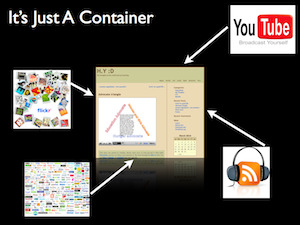
Blogs as Web-Based Portfolios Part 2
Finding the right Web-Based Portfolio Container
The most important idea to keep in mind when choosing a WBP is the flexibility it allows you in embedding content from other parts of the web. There are many amazing Web 2.0 programs that are being used in education and have embed codes that allow you to pull content from their sites and services into your WBP. VoiceThread, YouTube, Flickr, SlideShare, are just a few that students can use to create/manage content and pull that content back into their WBP. In the end, what your WBP needs to be is nothing more than a container for content of any kind or variety.
When choosing a WBP platform, understanding what its limitations are is critical to being able to know what you can fully do with the container itself.


Organization is Key
 With any portfolio organization is key. Blogs have a built in organization feature in what they call categories. Much like folders on your computer only more dynamic, categories make keeping your blog organized easy.
With any portfolio organization is key. Blogs have a built in organization feature in what they call categories. Much like folders on your computer only more dynamic, categories make keeping your blog organized easy.
Isabel, a 5th grade student at the International School Bangkok, has agreed to allow me to use her blog as an example for other educators to see how a blog can be used in the classroom. To the left you’ll see the categories that Isabel has created for her blog. Some of the categories, reading, science, writing, slice of lifes, are categories that her teacher has asked her to make and use for assignments and reflections from the classroom. The rest of the categories were created by her as she has written things both for class and on her own. Isabel uses her blog as a container to store her own learning over time, not all of it at school, and not all of it asked for by her teacher. The category “for specific people” has her reflecting on her 1st grade buddy, and friends.
You’ll also notice the category “for conference”. The week before her spring Student-Led Conference with her parents, she wrote learning goals to share with her parents during the conference.
Many teachers feel they need to control the WBP of the students. When the WBP is seen as “just another assignment” or something else students need to do for school, the interest is lost. The sense of ownership of the portfolio is lost and students’ interest in telling their stories, reflecting on their lives quickly fades.
That’s not to say that you can not require certain posts from students within their WBPs, but you must be careful in the limits you put on students on what they can post on ‘their’ site. Allowing students to write about what they did over Spring Break, a trip they took, a book they read, a movie they watched, a game they played all has relevance to the learning of that particular student. By reflecting on these other aspects of their lives they learn to think deeper, become more introspective, and of course just write more.
I’ve seen teachers who have tried to control the content that goes within the WBP and it doesn’t take long before all interest is lost. Giving the students a sense of ownership over their WBP not only shows respect and responsibility, but allows teachers to have open conversations about cyber safety, appropriate use of the Interent, and building a postive digital footprint.
 This generation, more than any before it expects to be able to customize every aspects of their lives. Whether it’s their own legos, their clothes, their shoes or their technology. Customization and the ability to put your personal brand on things that belong to us is a way to show ownership. It’s important that we allow students to customize their WBP in a way that allows their personality to show through. By using a blog platform, it is simple to allow students limited choice to customize their WBP. As a school you can decide what themes (colors, layou
This generation, more than any before it expects to be able to customize every aspects of their lives. Whether it’s their own legos, their clothes, their shoes or their technology. Customization and the ability to put your personal brand on things that belong to us is a way to show ownership. It’s important that we allow students to customize their WBP in a way that allows their personality to show through. By using a blog platform, it is simple to allow students limited choice to customize their WBP. As a school you can decide what themes (colors, layout, structure) you want your WBP to be. You can add themes or limit the number of options. It’s not the amount of options that matter, it’s the simple fact that there are options and that each student gets to choose the option they feel best represents their personality.
As educators it’s our job to build the systems that allow students to have WBPs to organize their thinking, reflect openly, and customize their space. There are a number of free and low cost solutions available to schools and districts today that make putting a system in place relatively easy. The hardest part will be determining what system best meets the needs of your school or district. It is important to determine if the system is scalable to the needs of the school or district, and put structures into place to ensure that the system can be maintained over time. All of these decisions need to be made locally. For me to say that it should be this way or that way without knowing the school or district is not feasible. Much like students in our schools, schools themselves are diverse places with different needs, and financial responsibilities. I am certain however, that there is a solution for every school out there. In the next section we will look at the options available to schools today and discuss the positive and negative aspects to consider when making a decision on a WBP system.








Thanks for continuing your blogs as WBP posts, Jeff. We’re looking at this model in our middle school for next year and your posts are a big help.
This is a great idea! This has been a big topic of discussion at our school and as a recent convert to blogging, the opportunities for student and teacher reflection are amazing.
Thanks, Jeff! It’s been great working with you this year to create WBP for my class. I really agree that it’s important to let students have ownership over their blogs. My students have been asked to create particular posts, but are often adding content of their own and really seem to feel that they have control over their blogs. As a first time blogger and being very new to blogs as a WBP, I’ve found them an amazing tool. Of course, we’ve got a long way to go and my students are still learning how to use them as a reflection tool. Your help has been invaluable though, Jeff, so thanks for your support!
You’ve done an amazing job supporting your student in creating their WBP. Students need to feel the site belongs to them and you’ve done that by allowing them to customize them and making it a big deal to have your own blog in 4th grade. It will be fun to follow them on in 5th grade next year as they continue to build their online presence and use their WBP to reflect on their learning. Kuddos to you for taking the risk and making blogs as web-based portfolios work in your classroom.
For everyone else you can find Cheryl’s blog and those of her students here: http://inside.isb.ac.th/cterry
Good stuff, yet once again, o’ Inland Emperor. At Cotopaxi, I pushed the use of Ning as a WBP venue or tool–specifically using the Blog feature in Ning, with students writing reflections, tagging their blog posts by Subject (i.e., “Math”, “Science”, etc.), inserting graphics, and attaching files–for students to post e-portfolio content. They used the WBPs in their Student-Led Conferences to increasing success this year (the “expansion year” of WBPs).
We looked at other blog options but settled on Ning mainly for the ease of setup and oversight for the mentor/homeroom teachers, and the option of keeping the Ning private (by invitation only)–and thus we side-step the issue of posting online publically pictures/videos of students and other materials with student names as the private Ning is only accessible by the students and grade level teachers (and administrators).
With Ning’s new pay structure forthcoming, this may jam us up a bit, but I hope that they will have some decent option for schools. This sure makes a case for hosting your own blog site! We’re looking at options for migrating from Ning if the pricing is ridiculous, but we also have a lot of teachers using Ning for classroom sites–student blogs, Forum-based class discussions, photo and video posts, etc.–and this means we’ll likely have to stick with Ning.
At any rate, the WBP is the way to go! We’re using our Ning-based approach from Grade 5-10 in different forms and fashions. We’ll likey get Grade 11 and 12 to get onboard with WBPs to document their IB Creativity Action Service (CAS) requirement.
Blogs, Wikis, or Nings–they all are great tools for WBPs!!!
[…] http://www.thethinkingstick.com/blogs-as-web-based-portfolios-part-2 […]
[…] http://www.thethinkingstick.com/blogs-as-web-based-portfolios-part-2 […]
Jeff – I stumbled across your blog early in this school year and I would like to thank you for the wealth of information and your student-centered, student empowering approach. I’m an international school HS English teacher in China, where I tried to bring my “blog as e-portfolio” strategy with me, but failed due to the Great Firewall and other technology challenges. I’m planning for my courses at my next school in Europe and your ideas, especially in this installment, are really helping me to crystallize a complete strategy for a WBP. Thanks again and keep the ideas coming.
On a different note, I hope you and all in the ISB community are safe and sound during this time.
Thanks for reading Ian and good luck with your WBP!
[…] I also like is that because our container is a blog, we're not limited to just text. Videos, audio, images….kids can decide which medium best […]